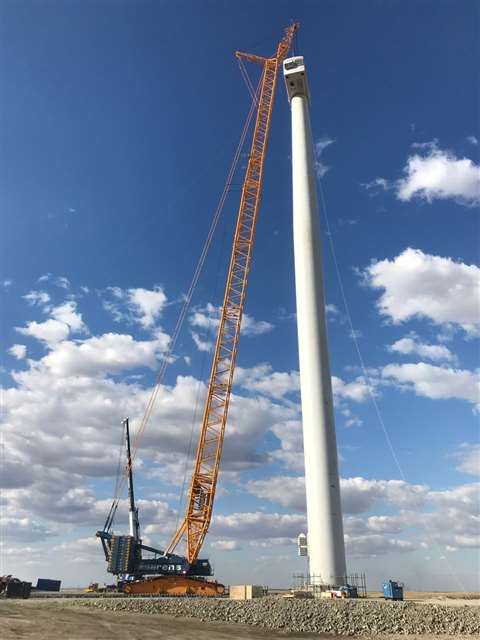Sarens Installs 13 Wind Turbines at Kazakhstan Project Site
04 May 2020

Sarens was recently involved in unloading several wind turbine parts and installing thirteen turbines at a project site in Badamsha, Kazakhstan. The work was performed on behalf of customer GE and project owner ENI.
To unload and install the turbines, Sarens used the following equipment:
- LR 1600-2
- AC 500-2
- LTM 1160
- Tadano ATF 130G
- Demag AC 80
The cranes were sent from the Sarens base in Atyrau, Kazakhstan, a journey of about 800 kilometres. With the equipment on site, the Sarens crew then needed to unload and install all of the turbine parts in the same location. To do this, they worked in two teams: one unloaded turbine parts using the AC 500-2 and the ATF 130 cranes, and the other erected them using the LR 1600-2 and LTM 1160 cranes.
Unloading turbine parts
Sarens used the Demag AC 500T and Tadano ATF 130G cranes to unload the turbine parts. This combination of cranes was chosen because a single crane could lift the heaviest wind turbine part, the nacelle, which weighed 96 tonnes, while two cranes working together could lift other parts which were not as heavy but were long. The AC 500T and ATF 130G made the unloading process fast and easy.
It was important for the crew to unload all parts accurately and within the lifting range of the LR 1600-2, which would later perform the final erection. It was also necessary to allow enough space for assembling and dismantling the LR 1600-2 crane. These measures would avoid double-handling of turbine equipment.
Installing turbines
With the unloading complete, the second Sarens team began to erect the wind turbines, first using the LTM 1160 to assemble the LR 1600-2 crane that would be used for installation. The Demag AC 80 was also used to help assemble, and later dismantle, the LR 1600-2. The LR 1600-2 took four days to set up, test, and get ready to work.
Each wind turbine to be erected included three 30-metre tall tower sections, three 63-metre blades, one 96-tonne nacelle, one hub, and one set of generator DTA tools. The LR 1600-2 in SL3F configuration did an excellent job lifting each part in place, thanks to its lift total of 105 tonnes at a 17 metre radius.
After the team erected each turbine, the crane would be partially dismantled and moved to the next turbine, a process which took three days.
While the 26-person team worked efficiently, one of the biggest challenges they faced was high wind speeds, which sometimes meant it was impossible to boom up the crane or proceed with a lift.
“Wind has been the biggest challenge,” explains project manager Alok Kumar Gupta. “We needed to continuously monitor the wind speed and plan lifts accordingly. Sometimes we would work at night, when wind speeds were lower.”
Sarens would like to thank the 26 people involved in this project, including the project manager, site supervisor, site engineering, HSE rigger, and operators, as well as the Atyrau base which provided administrative support.
